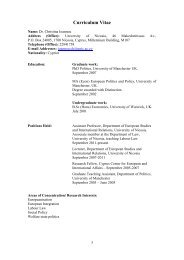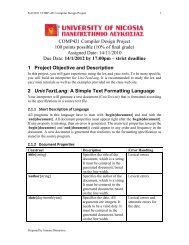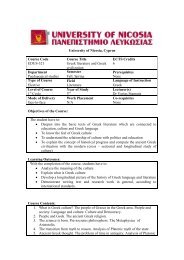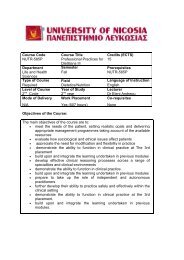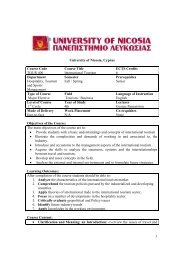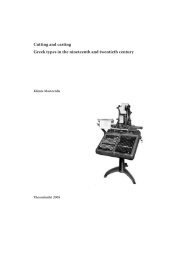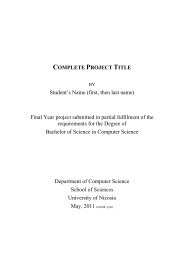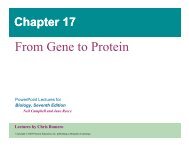University of Nicosia, Cyprus Course Code BIOL-221 Course Title ...
University of Nicosia, Cyprus Course Code BIOL-221 Course Title ...
University of Nicosia, Cyprus Course Code BIOL-221 Course Title ...
You also want an ePaper? Increase the reach of your titles
YUMPU automatically turns print PDFs into web optimized ePapers that Google loves.
<strong>University</strong> <strong>of</strong> <strong>Nicosia</strong>, <strong>Cyprus</strong><strong>Course</strong> <strong>Code</strong><strong>BIOL</strong>-<strong>221</strong><strong>Course</strong> <strong>Title</strong>Human NutritionECTS Credits6DepartmentLife and Health SciencesSemesterFall/SpringPrerequisitesNoneType <strong>of</strong> <strong>Course</strong>RequiredFieldBiology, NutritionLanguage <strong>of</strong> InstructionEnglishLevel <strong>of</strong> <strong>Course</strong>1 st CycleYear <strong>of</strong> Study2 nd LecturerDr. Elena PhilippouMode <strong>of</strong> Delivery Work Placement Co-requisitesface-to-face N/A NoneObjectives <strong>of</strong> the <strong>Course</strong>:This course will cover the physiological metabolic requirements and theinterrelationships <strong>of</strong> diet components which are determinants <strong>of</strong> human health anddiseases. The main objectives <strong>of</strong> the course are to:• Make students aware <strong>of</strong> healthy eating guidelines and their importance.• Utilize case studies to demonstrate the relationship between diet and disease, theintegration <strong>of</strong> body physiology requirements and the function and properties <strong>of</strong> themacronutrients (carbohydrate, protein and fat), vitamins, minerals, and water.• Discuss the basic principles <strong>of</strong> the metabolic/hormonal pathways regarding nutrienthomeostasis and water balance and get students to practice on calculations <strong>of</strong>metabolic rate and energy requirements.• Use case studies to demonstrate the role <strong>of</strong> diet in helath and disease.• Make students aware <strong>of</strong> the diagnostic criteria for eating disorders.• Provide students the opportunity to review and report on relevant research literature.Learning Outcomes:After completion <strong>of</strong> the course students are expected to be able to:1. Recall nutrition guidelines, classify the major food groups and discuss theirimportance in everyday diet and use the food pyramid in decision making aboutfood choices.2. Associate food sources and nutrient concentrations with the main metabolicrequirements <strong>of</strong> the human body for water, energy, macronutrients, vitamins andminerals with regard to age, gender and the deficiency symptoms.3. Calculate basic metabolic rate and energy requirements using standardcalculations and explain the maternal, fetal and infant nutrient requirements4. Differentiate the main causes <strong>of</strong> food borne disease and discuss their symptoms,prevention and treatment.5. List and differentiate the diagnostic criteria <strong>of</strong> the major eating disorders.6. Identify the main causes <strong>of</strong> food intolerances and allergies.
7. Recall the nutrition guidelines in relation to different life stages and life styles.8. Use scientific literature to report on current issues related to human nutrition.<strong>Course</strong> Contents:1. Introduction to nutrition – basic concepts, Healthy eating, Mediterranean diet,overview <strong>of</strong> food groups2. Food Carbohydrates: sugar, starch, fiber, health effects <strong>of</strong> carbohydrates3. Food fat, cholesterol metabolism, atherosclerosis, and heart disease.4. Food protein, vegetarianism5. Energy homeostasis in humans, Scientific methods <strong>of</strong> measuring energyintake/expenditure, energy balance and obesity6. Fat-soluble vitamins7. Water-soluble vitamins8. Minerals: calcium and magnesium9. Iron and anaemia; Water10. Food safety: foodborne illness11. Pre-pregnancy, pregnancy and lactation12. Nutrition Related to exercise, fitness and sports13. Food allergies and intolerances14. Eating DisordersLearning Activities and Teaching Methods:Lectures; Cooperative learning activities, Discussions; Review <strong>of</strong> literature.Assessment Methods:Assignments, Tests and Mid-term Exam; Final ExamRequired Textbooks/Reading:Authors <strong>Title</strong> Publisher Year ISBNJ. Mann, S.TruswellEssentials <strong>of</strong>Human NutritionOxford <strong>University</strong>Press2002 ISBN:0198508611Recommended Textbooks/Reading:Authors <strong>Title</strong> Publisher Year ISBNMcGuire M,Beerman KAUSA: WadsworthCengage Learning2007 978-0-534-53717-3Gibney MJ,Lanham-NewSA, Cassidy A,Vorster HHNutritionalSciences. Fromfundamentals t<strong>of</strong>ood.Introduction toHuman NutritionOxford, UK:Wiley-Blackwell2009,2 nd ed.978-0-534-53717-3



